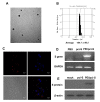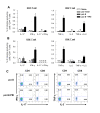Intranasal immunization with plasmid DNA encoding spike protein of SARS-coronavirus/polyethylenimine nanoparticles elicits antigen-specific humoral and cellular immune responses
- PMID: 21194475
- PMCID: PMC3023737
- DOI: 10.1186/1471-2172-11-65
Intranasal immunization with plasmid DNA encoding spike protein of SARS-coronavirus/polyethylenimine nanoparticles elicits antigen-specific humoral and cellular immune responses
Abstract
Background: Immunization with the spike protein (S) of severe acute respiratory syndrome (SARS)-coronavirus (CoV) in mice is known to produce neutralizing antibodies and to prevent the infection caused by SARS-CoV. Polyethylenimine 25K (PEI) is a cationic polymer which effectively delivers the plasmid DNA.
Results: In the present study, the immune responses of BALB/c mice immunized via intranasal (i.n.) route with SARS DNA vaccine (pci-S) in a PEI/pci-S complex form have been examined. The size of the PEI/pci-S nanoparticles appeared to be around 194.7 ± 99.3 nm, and the expression of the S mRNA and protein was confirmed in vitro. The mice immunized with i.n. PEI/pci-S nanoparticles produced significantly (P < 0.05) higher S-specific IgG1 in the sera and mucosal secretory IgA in the lung wash than those in mice treated with pci-S alone. Compared to those in mice challenged with pci-S alone, the number of B220+ cells found in PEI/pci-S vaccinated mice was elevated. Co-stimulatory molecules (CD80 and CD86) and class II major histocompatibility complex molecules (I-Ad) were increased on CD11c+ dendritic cells in cervical lymph node from the mice after PEI/pci-S vaccination. The percentage of IFN-γ-, TNF-α- and IL-2-producing cells were higher in PEI/pci-S vaccinated mice than in control mice.
Conclusion: These results showed that intranasal immunization with PEI/pci-S nanoparticles induce antigen specific humoral and cellular immune responses.
Figures




References
-
- Wang B, Ugen K, Srikantan V, Agadjanyan M, Dang K, Refaeli Y, Sato A, Boyer J, Williams W, Weiner D. Gene inoculation generates immune responses against human immunodeficiency virus type 1. Proceedings of the National Academy of Sciences. 1993;90:4156–4160. doi: 10.1073/pnas.90.9.4156. - DOI - PMC - PubMed
Publication types
MeSH terms
Substances
LinkOut - more resources
Full Text Sources
Other Literature Sources
Medical
Research Materials
Miscellaneous

